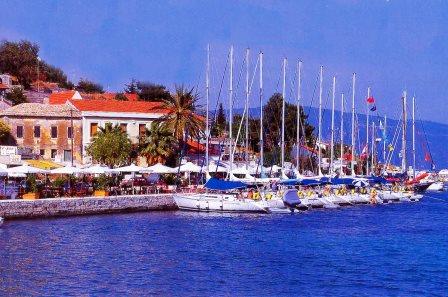Pylaros spreads at the south part of Erissos penninsula. Although it does not extend so far, Pylaros has many idyllic places and a lot of history. Above all, it has one of the most beautiful beaches world-wide: the unique Myrtos.
The name of Pylaros derives from the word “pyli” (the gate). Because of the mountainous of the island, Pylaros served as one of the main entrance in Kefallonia. Due to the fact that many areas of Kefallonia are geographically secluded, the islanders for many centuries had not developed domestic communication. In this occasion the only communication was made through the sea, and the port of Agia Ephfimia – and probably Myrtos in ancient times- answered this purpose.
In Pylaros there are many cyclopean-structure ruins, as well as roman ones. In recent times, Pylaros played an important role in the National Resistance.
Historical churches climb up the rough slopes of the mountains and the Pylaros-dwellers have a very long history in cheese production, thanks to the fact that the cattle-breeding was for centuries the principal income of this area.
GOATS WITH … GOLD TEETH WHICH DON’T DRINK WATER!
THE TRADITIONAL CHEESE PRODUCTION
A very old legend mentions that the goats grazing on the mountains of Pylaros drink no water from October to May. This phenomenon was solved lately. Owing to the presence of great moisture in the air, the goats turn their heads to the blowing wind and breathe the moisture, therefore they don’t need drinking water.
The great Greek philosopher of the 4th century b.C. Aristotle says that, the hare and the goats living in Agia Dynati mountain have … gold teeth. This is owing to the composition of the soil because it contains mica.
Many of the residents in Pylaros who were working in cheese production were very famous. They used to work in their native land or far away bringing with them their knowledge. Today the production is of high quality, the cheese is very pure –as it was in ancient times-, and the taste is always savoury and peppery. Don’t forget to eat traditional bread with feta cheese, or kefalotyri, kefalograviera, formano and myzithra.
AGIA EPHFIMIA: Picturesque village, seat of the former Municipality of Pylareon, with an excellent street-plan laid out in 1878, and a friendly harbour, capable to provide hospitality for many boats. During the summer, ships set sail across the way and in the port many boats find leeward and organized shelter turning Agia Ephfimia into a cosmopolitan centre. If you are interested in hiring boats, you can find some in order to discover the nearby fantastic see-corners.
The name of this provincial town derives from the homonymous church near the harbour, which celebrates on July, 11th. At this day pallikaria (e.g. stout –hearted men) from the area dance Divaratikos and Ballos.
At the edge of the town there are many antiquities –mosaic floor, hydraulic and heating installation in a roman villa-. After about 800 m. towards Siniori-Myrtos, in a site named Palatia, there are the ruins of an ancient building of cyclopean structure.
In the Byzantine Museum in Athens the iconostasis from the church of Agios Nikolaos is exhibited.
POTAMIANATA: At the entrance of the village stands the semi-ruined windmill as a remembrance of the past. Take a photo near the cistern, dated to the 18th c. The whole area was considered as a very effective mylotopos, a place with favourable for the grinding winds. Therefore, many windmills were constructed in Pylaros.
Before the windmill stands the statue of Marinos Antypas –he was born in another village of Pylaros, in Ferentinata-. He lived at the end of the 19th c. and became a hero because his murder (on March, 1907) from the landowners in Thessalia, signaled the beginning of the great agricultural uprising in Kileler.
THE MONASTERY IN THEMATA: An earth- road leads to the very old monastery which links Kefallonia with Byzantium. It is dedicated to Theotokos and its foundation dates back to 1096. Rare manuscripts and holy relics are there housed. The view from the slope of Agia Dynati is fascinating and the monastery stands in the centre of a dense forest of holm-oaks.
TARKASATA: An oblique earth-road before the Monastery of Themata leads to the abandoned village of Tarkasata. It is worthwhile wandering on its paved and weedy lanes. Have a look at the old church, the kiln, the threshing floor and the ruins of the stone houses, the owners of which were famous cheese-makes and cheese merchants.
FERENTINATA: At the entrance of the village you can admire the remnant of the splendid belfry, the height of which is said to be more than 30 m. The Kefallonians who lived in Russia decided to collect money in order to erect this belfry. It was constructed from porous stone brought from Malta, and at its construction worked master builders from Metsovo (Epirus).
AGIA EPHFIMIA: Crystal clean beach in front of the harbour.
SMALL BEACHES TOWARDS SAMI: Alongside the road leading to Sami and near Agia Ephfimia, there are many beached induce you to swim. Pay attention during your descent on the slab-shaped rocks. If you decide to swim there, a small beach … of your own will be your reward.
MYRTOS: The paradise in the earth! The delirium of the blue sea! The most beautiful beach in Greece and Europe, and the third beach world-wide. A great musical concert is given at the night of the full moon in August. Eventhough you may feel frighten of the deep and abrupt sea waters, try your descending. You will feel a very unique, strong and unforgettable emotion: the blue expanse of the vastness somewhere between sea and land!
Evridiki Livada

